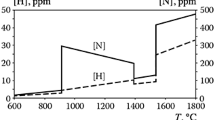Summary
The steel products of the Celts (knives, axes, swords) are multilayer objects, produced by the process of fire welding from steel rods having different chemical compositions. Celtic metallurgists used phosphorus as an alloying element. To obtain suitable alloys, they smelted phosphorus containing iron ores in shaft furnaces; alternatively, a phosphorus slag former (e.g. animal bone meal) was added. The combination of appropriate materials (steel rods with a phosphorus content varying between 0.2 and 0.7 % mass) and sophisticated forging techniques allowed the Celtic smiths to obtain workpieces showing superb hardness and tenacity. Moreover, a layer of fine-grained goethite (rust) on the workpiece surface served to protect these Celtic steel products from corrosion.
Zusammenfassung
Die Stahlprodukte der Kelten (Messer, Beile, Schwerter) sind Mehrlagenwerkstoffe. Sie wurden aus Stahlstäben mit unterschiedlicher chemischer Zusammensetzung von den Schmieden durch Feuerschweißen hergestellt. Als Legierungselement wurde von den keltischen Metallurgen Phosphor verwendet. Das Legieren von Phosphor erfolgte durch Verhüttung phosphorhaltiger Eisenerze oder durch Aufgabe phosphorhaltiger Schlackenbildner (Tierknochenmehl) im Schachtofen. Mit dieser Werkstoffauswahl (Stahlstäbe mit unterschiedlichem Legierungsanteil an Phosphor von 0,2 bis 0,7 Masse-%) und Schmiedetechnik wurden von den keltischen Schmieden Werkstücke mit hoher Härte und Zähigkeit erzeugt. Durch die Bildung von feinkörnigem Goethit (Rost) an der Werkstückoberfläche waren die keltischen Stahlprodukte korrosionsbeständig.
Similar content being viewed by others
Literaturverzeichnis
Preßlinger, H., C. Eibner und B. Preßlinger: Das bronzezeitliche Kupferindustriegebiet Flitzen Alm in der Gemeinde Gaishorn. Da schau her 30 (2009), Heft 3, 24–27
Preßlinger, H., C. Eibner, G. Walach und B. Preßlinger: Die Ur- und Frühgeschichte der Marktgemeinde Gaishorn am See. Heimatbuch Gaishorn am See. Hrsg: Weiß Karl, Marktgemeinde Gaishorn am See (2007),16–33
Preßlinger, H., und M. Mayr: Celtic steel – an evaluation of depot finds. steel research 72 (2001), Heft 8, 283–290
Preßlinger, H.: Keltischer Stahl aus Linz – Metallkundliche Voruntersuchungen der Depotfunde vom Gründberg/Stadtgemeinde Linz. Archaeologia Austriaca 82/83 (1998/99), 511–515
Preßlinger, H.: Untersuchungsergebnisse von keltischen Stahlprodukten. Stahl u. Eisen 123 (2003), Nr. 3, 117–118
Preßlinger, H.: Metallkundliche Untersuchungen an Depotfunden in Bad Aussee. Fundberichte aus Österreich, Wien 2005, Band 43, 325–330
Preßlinger, H., E. M. Ruprechtsberger und O. H. Urban: Stahlwerkstoffe in der Kelten- und Römerzeit – Teil 1. BHM 152 (2007), Heft 5, 146–150
Preßlinger, H., E. M. Ruprechtsberger und O. H. Urban: Stahlwerkstoffe in der Kelten- und Römerzeit – Teil 2. BHM 152 (2007), Heft 7, 232–234
Preßlinger, H., O. H. Urban und E. M. Ruprechtsberger: Norischer Stahl – Beurteilungsergebnisse römerzeitlicher Funde vom Magdalensberg in Kärnten. res montanarum (2007), Heft 41, 51–54
Preßlinger, H.: Phosphorlegierter Stahl – ein Werkstoff der keltischen Schmiede im Donauraum. res montanarum (2007), Heft 41, 55–59
Preßlinger, H.: Der Mythos über das Härten von Stahl. res montanarum (2007), Heft 41, 60–64
Kubaschewski, O.: Iron – Binary Phase Diagrams. Springer-Verlag Berlin-Heidelberg-New York; Verlag Stahleisen Düsseldorf (1982), 84–86
Oelsen, W.: Zur Thermodynamik der Eisenlegierungen. Stahl u. Eisen 69 (1949), Nr. 14, 468–475
Bleck, W., und W. Müschenborn: Möglichkeiten und Grenzen zur Beeinflussung der Werkstoffeigenschaften bei warm- und kaltgewalztem Stahl. Thyssen Technische Berichte (1984), Heft 1, 24–33
Stiaszny, P., A. Pichler, H. Preßlinger und E. Till: Höherfestes Stahlfeinblech – Ein altbekannter Konstruktionswerkstoff in der Automobilindustrie? Seminarband – Neue Entwicklungen in der Blechumformung. Hrsg: Siegert, Klaus, Institut für Umformtechnik, Universität Stuttgart, DGM Informationsgesellschaft-Verlag (1996), 299–322
Kimura, M., and H. Kihira: Nanoscopic Mechanism of Protective Rust Formation on Weathering Steel Surfaces. Nippon Steel Technical Report (2005), No. 91, 86–90
Kimura, M., T. Suzuki, G. Shigesato, H. Kihira and S. Suzuki: Characterization of Nanostructure of Rusts formed on Weathering Steel. ISIJ International 42 (2002), No. 12, 1534–1540
Misawa,T., M. Yamashita, H. Miyuki und H. Nagano: Protective Rust Layer Formed on Weathering Steel by Atmospheric Corrosion for a Quarter of a Century. Corros. Control Low-Cost.; Proc. Int. Corros. Congr., 12th (1993),Vol.2, 612–623
Schürmann, E.: Die Reduktion des Eisens im Rennfeuer. Stahl u. Eisen 78 (1958), Heft 19, 1297–1308
Author information
Authors and Affiliations
Rights and permissions
About this article
Cite this article
Preßlinger, H., Eibner, C. Phosphorlegierter keltischer Stahl – hart, zäh und korrosionsbeständig. Berg Huettenmaenn Monatsh 154, 534 (2009). https://doi.org/10.1007/s00501-009-0512-8
DOI: https://doi.org/10.1007/s00501-009-0512-8




